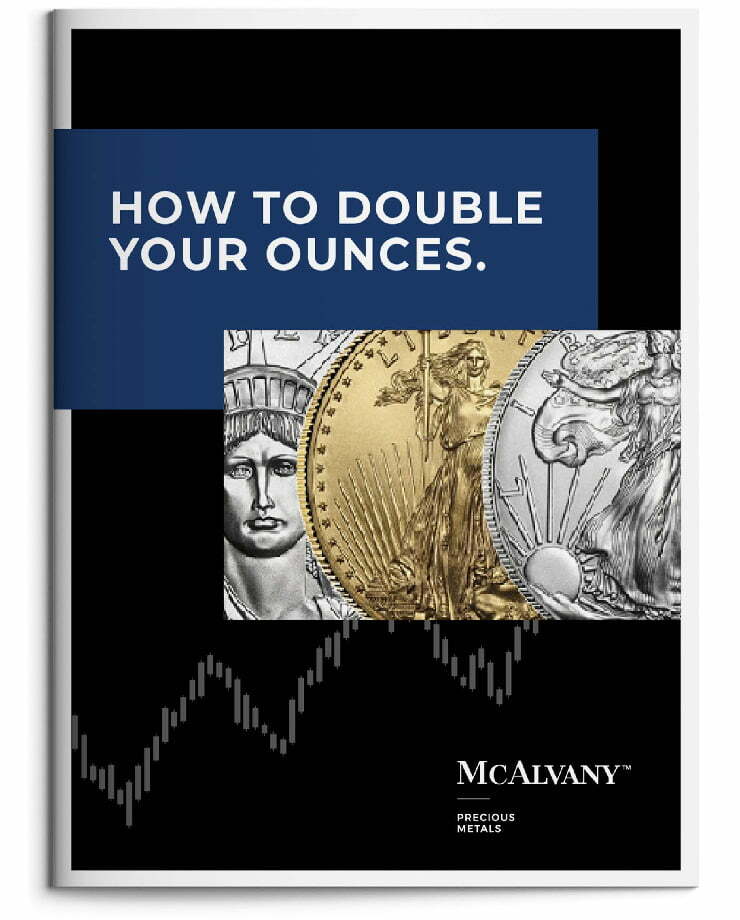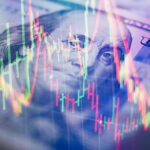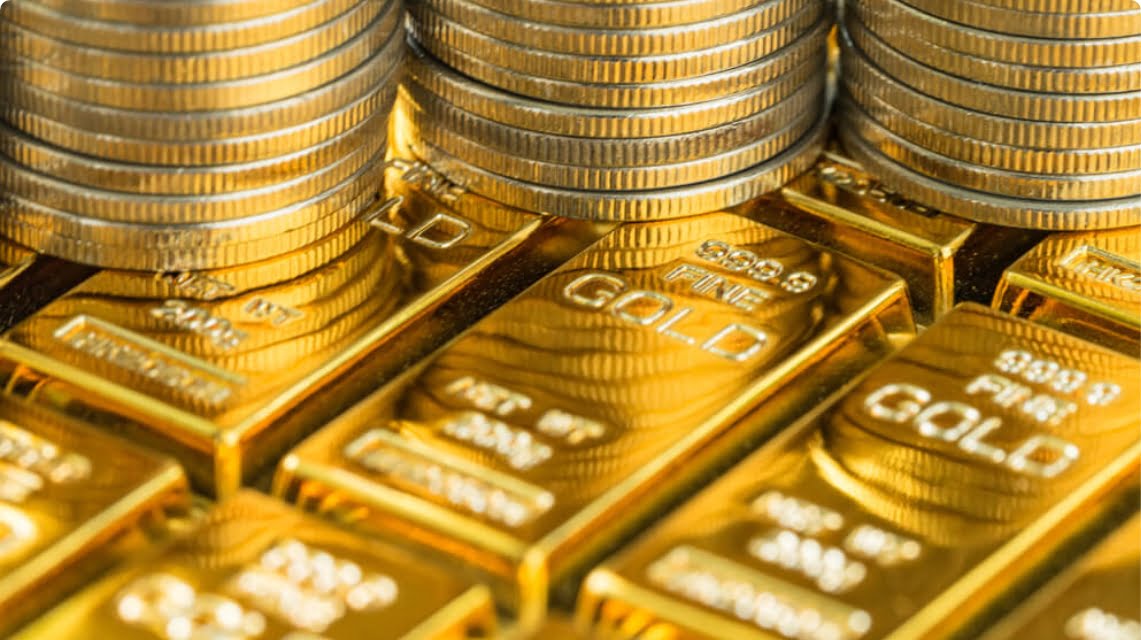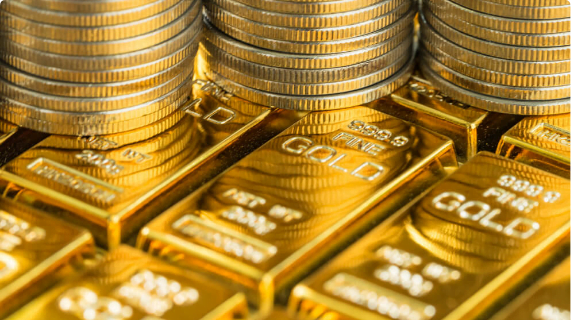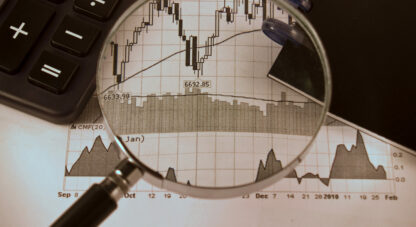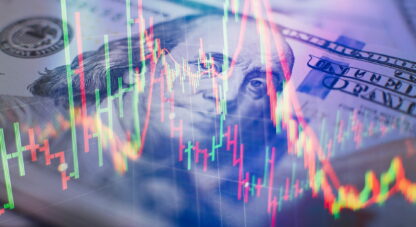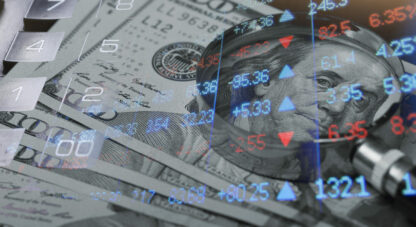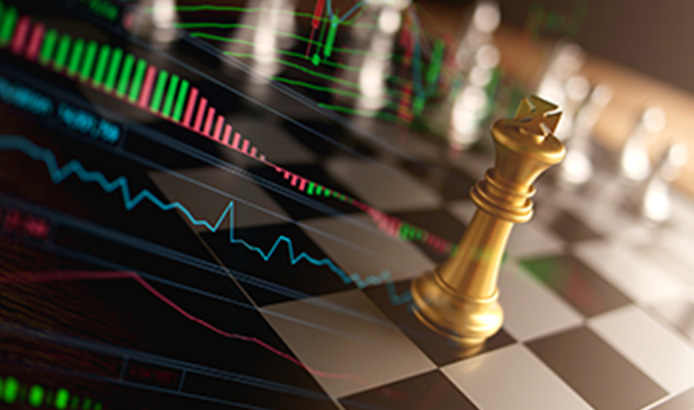Podcast: Play in new window
- Gold Price In Dollars To Rise
- China Approves Gold Now In Its Insurance Company Portfolios
- Russian Consumer Demand For Gold Up 60% Since Ukraine Invasion
"A weaker dollar is on the agenda, and this is a decided shift to force the dollar lower on a managed basis, ultimately will require a multilateral currency agreement that takes the dollar lower relative to its global peers. We'll have to have participation from other central banks as we orchestrate that. The Plaza Accord accomplished this in 1985, and a version of that is a growing likelihood." —David McAlvany
Kevin: Welcome to the McAlvany Weekly Commentary. I'm Kevin Orrick, along with David McAlvany.
Well, it was a quick trip, but I have to say aloha. Welcome back.
David: The halfway point between the Philippines and Durango, Colorado is Honolulu—Waikiki.
Kevin: Honolulu with a— Didn't you say you got a convertible and you just drove all around the island up to the North Shore?
David: Oh, got a great deal, and took my parents all over the place. Yes, we're going to talk about gold.
Kevin: Yeah.
David: Yeah. New all-time highs warrant a conversation. It's trading over 2,900 this week. My call on Bloomberg Television a month back for 3,250 in 2025 seems a little less far-fetched.
Kevin: It feels sort of daring when you do it and now you can look at it and go, "Okay, 3,250." We're very, very close to that, but let's go back to the trip. You have been out of the office now for the last week. Is there perspective that comes when you step away from the chaos?
David: Definitely. A few days out of the office, a few days with my parents brings perspective. I'm grateful for our annual meetups, and I hope we have a lot more of them. I treasure each one of them.
Kevin: I love the fact that you guys are so deliberate year after year after year. Think back, Dave. Think back to some of the great trips that you've had with your parents.
David: Oh, well, one that stands out, I remember a trip to Manhattan with my parents to celebrate what was our first anniversary and their 30th. We were living in Boston at the time, so New York was a short stretch away. Now I'm approaching, still have five years, a 30th anniversary of my own. Life happens that fast. You blink, and decades have passed.
I think we're confronted with inescapable moments of self-reflection, and sometimes those are at big life events. Think of your family, weddings, funerals. You get together and it's reflecting back and you see how much has changed in the time that's passed in between. Outside of the best man's toast and the epitaph—between them, I should say—there's a blur of days and years and decades. I think some of us with a melancholy streak or sentimental soft spot reflect a little more often and don't need those big days for inspiration. Most days, frankly, are strung together in sort of an undifferentiated stream like frames in a film reel.
Kevin: I just got off the phone with a client before we stepped into the studio. These folks own a ranch up in Oregon—or farm, actually—and they just had a new lamb that was born right before we talked. She had to run out the door to chase off predators actually, but they had been accumulating precious metals for years. They listen to the Commentary. I got to know them more than a decade ago, but they said, "Kevin, I just want you to know as we go through this triangle update, is what we call it, we are really thinking about our grandkids at this point." He said, "A lot of people think about their kids for inheritance. We're already on grandkids." And I said, "Well, Dave calls that legacy. Legacy investing. It's a legacy mindset." There's a lot of things to count other than money, right? I mean, we value a lot of things.
David: Sure. I mean, we're in the investment business. We're constantly toggling between present value and future value. We assign resources for a positive outcome in the future, and we're weighing and carefully allocating risk and reward. A lot of what we do is measured in dollars and cents, maybe ounces too, but not everything of value can be measured that way. A few days out of the office stirs the question: do we allocate enough time and energy, other resources, to the relationships in our lives?
I don't think we'll ever regret having spent more time with family and friends. We don't choose all our memories, but we can choose how we curate life together. And in so doing, we curate the memories we'll revisit at some point in the future. For me, having the top down and taking my mom to the beach and having a picnic, that's a future memory for me. Meals are meaningful to me. Any component that can elevate the simple caloric hog trough into something beautiful and memorable is significant to me. You've been in our kitchen before. Our spice rack is excessive.
Kevin: Yeah. And your wine closet.
David: It might be excessive, too, but it's my best attempt to try and capture the present moment and infuse it with something lasting, toggling back and forth between present value and future value, maybe with a hint of nostalgia.
Kevin: I was reading a book last night. It actually made me think of you because it's talking about really appreciating a fine wine. This gal that wrote this book talked about a vintner up in Oregon who said he no longer measures the value of his wines the way he used to, the way they smell, the way they taste. He said, "It actually is the way the rest of the night goes as far as relationship, whether it's with my wife or with whoever I'm serving or drinking it with." It's how the rest of the night goes. That, a lot of times, is satisfying to him as to how the wine turned out. It reminds me of you, but I've got to move on, though, because people are sitting here going, "Okay, wine, Hawaii."
David: "What about gold?"
Kevin: "What about gold?"
David: Let's go. Come on.
Kevin: Tariffs. Tariffs.
David: Yeah. Well, tariffs are having their effect in a few unexpected ways, and you'd expect friends and foes alike to be annoyed. It's no surprise that the geopolitical and trade networks we're accustomed to thinking about, they're being stressed. Old alliances are in question, new ones are not yet settled.
Kevin: Is that why so many people are wanting to bring their gold over from London to the United States, that stress?
David: Well, I think one unexpected turn in recent weeks is in the gold markets, where contract traders playing in the futures markets are not certain whether there is sufficient gold available for delivery in the US market, and not knowing what tariffs might apply to metals moved from the London market to meet demand, they're moving the metals now. First, as a safety measure. So you get billions in gold leaving London for New York. I'm not exactly sure what it means, but it's interesting in part because it underscores the real scarcity of fabricated metals. At a certain point, the London Metals Exchange will look like it's been strip mined if its flows continue at the pace they are now.
Kevin: Well, Dave, a lot of that is emotion. Markets can be moved by emotion, but once a year the World Gold Council publishes actual statistics. I think when you were away, you went through those statistics. What are the facts saying about supply and demand right now?
David: Yeah. World Gold Council puts them together quarterly, and then, of course, the end of the year, you've got the annual look too. Their stats are out. Our friends at StoneX ran some telling analysis. We had official purchases by central banks for 2024 tallied to 1,045 tons. If you recall prior to the Russian invasion of Ukraine, the average from about 2009 till 2021, 2022 was 500 tons. So it's double the pace and it's been consistent at about 1,000 tons per year. Probably not a surprise that Russia was in the hunt for ounces. Poland was in the hunt for ounces. Turkey, China, India. It's reserve managers making good on their intentions to diversify financial assets to something more tangible.
Kevin: I'm just wondering how broad that's going to be, because one of the guys that we work with here, he's been in the metals market for close to 50 years, and he is getting calls for offers on his bags of copper pennies. Are we going to see this spread out through other commodities? I mean, actual, real things?
David: Well, if they are consistent, if the Treasury is consistent and takes pennies and nickels out of circulation because it costs two cents to create one penny, then, yeah, I think we could see them trade at premiums. Probably not anything— I wouldn't be hoarding pennies at this point.
Kevin: That's a lot of weight to bear around, but what about silver?
David: Well, a broader list of commodities someday make a short list of reserve asset diversifiers. Silver could be on that list. Silver has a monetary legacy which could put it on that list. I know bitcoin is of interest in some circles, but my guess is that, as we march towards quantum computation—and this week Intel has announced a new quantum effort with a Japanese company—I think you'll see the value of a receipt for a complex math puzzle might not be ever and always higher.
Schumpeter comes to mind. I ran out of time on the plane, but I downloaded a PDF from some of his 1919 writings. "The march of progress is the march of creative destruction, and technology is constantly disrupting itself. Somehow, the old and seemingly anachronistic gold is still relevant." So as we get to 2,900 this week, hooray for the precious metals.
Kevin: I got a call from a second cousin of mine. He was one of the missionary pilots back in the days. Remember Jim Elliot down in South America?
David: Mm-hmm.
Kevin: He was a missionary pilot right after that period of time when Jim Elliot was down there. He owns a little bit of gold. He's dabbled in bitcoin, and he asked me, he said, "Do you think maybe gold is at some point going to become out of fashion and bitcoin might replace it?" And I said, "Eddie, think about Peru. Okay. Would you fly down with a bunch of bitcoin into the jungles of Peru?" Remember those days?
David: Sure.
Kevin: And he goes, "You're right. I think even in those places, as archaic as it feels here, it's something that could be traded elsewhere."
David: And it's admittedly archaic in a digital world, but that is what has appeal to central banks. It's like a compass in the world of GPS. It still works regardless of whether or not the infrastructure is supportive. Hard assets are wealth stores which you can possess, and reserve managers are keenly aware of the risk implicit to a digital entry.
Yet another year has passed and the bias towards off-grid assets has been expressed again by the managers of global money supply, and that off-grid is really, really critical.
333 of the 1,045 tons were picked up in the fourth quarter, so actually an accelerated pace as the year ended. Strip out the countries that hold very large reserves as a holdover from their gold standard days going back 80 to 100 years ago, and the average allocation by central bank reserve managers is around 12%. 20% is a reasonable target and we expect the accumulation to continue. You've got many advanced economies that are between 50 and 75%, just for perspective.
Kevin: Well, and there are some countries where people wear their wealth. I mean jewelry demands something to always watch as well.
David: In dollar terms, demand for jewelry was higher in the fourth quarter by 19% versus the previous year, 37% higher than the previous quarter, totaling about $144 billion. Down 12% in tonnage, so, again, it's one of those things that's interesting. More money flowing in was positive, but at higher prices you get fewer ounces. 1,877 tons for wearable wealth, and more money flowing in buys fewer ounces, so you had both higher dollar volumes and lower total ounces consumed.
Kevin: Well, and actually we do mainly coins and bars. What was the demand like there?
David: Coin and bar demand in Q4 was up 40% compared to Q4—and this is globally—that's Q4 2023. 34% higher than in the third quarter 2024, so totaled $91 billion. In ounces, it was down 3%. Over the counter investment, of which we are a part, declined in Q4. Anecdotally, even as gold has moved higher by 10% since January 1, it's dead. Transaction volume is very low. We're not seeing sort of a mad rush into gold at 2,900. It still is dominated by those large central bank purchases.
Kevin: Yeah. So there's an illusion with gold going up as much as it is that you've got a lot of people here in America that are actually running in and buying it.
David: I take this as a constructive setup for long-term pricing. These price levels are not being achieved on a frenzied or fear-driven basis. The Western investor has yet to step in, but I think that is eminent.
Kevin: Yeah. But the high net worth individuals and institutions, they're buying.
David: Yeah, high net worth individuals decided it was time to own gold in 2024. Bar demand increased, while coin demand declined. Investor declines were most noticeable in the US and Europe. Those declines were more than offset by Chinese and Indian inflows.
Kevin: Well, and you really watch ETFs to see what's happening in the west as well, don't you?
David: Certainly, it tells you where investor appetite is. ETF tonnage declined in the first part of the year, nearly recovered to a slight loss of seven tons for the full year. I think a swoon in equities will see a huge push into the ETFs, and I think that's very much a preview of coming 2025 attractions.
Kevin: So for full year demand, what did the World Gold Council put the number at?
David: $382 billion. Fourth quarter accumulation was one of the strongest in 25 years, almost certainly attributable to geopolitical risk mitigation and central bank allocation. But again, if you look at the high net worth individuals, this is a stickier set. It's different than a hedge fund buying today to sell tomorrow. They're owning it for strategic reasons.
Kevin: Yeah. Well, and then there's still contracts. I mean, most gold is still traded on paper.
David: Sure. Contract interest is increasing in the US. The futures market speculators are more and more active. The way we count the COT reports, the Commitments of Traders reports, we would not be surprised by a correction given the kind of activity we're seeing in the metals markets.
On the other hand, we're nowhere near all time highs. Gold sentiment, while it's warming up, it's not red-hot. The COTs are a little bit different than the sentiment indicators. Year-to-date returns for gold are over 10%. Silver has also moved up by a similar amount, and it threatens to break out above that $33 mark, in which case it would likely take the performance lead.
Kevin: We talked about this last week, but Trump and his people are talking about a major, major monetary regime shift, and that would be, you said during the meeting, a devaluation may be around the corner.
David: Yeah. And one more thing of note for this week is the Chinese insurance regulators approving 10 insurance companies to allocate to physical gold. Bloomberg reports the allocation limit is set at 1% of assets. This is a trial balloon, so to say. They want to see how it's integrated into the insurance company portfolios, and they've capped it at 1%. That's equal to $27.4 billion.
So we have an under-allocated asset in the West and we have a completely unallocated pool of capital in China within the insurance industry, which has just been given permission to allocate to gold. That is promising for demand in 2025, and equal to about 295 tons. Will it stay at 1%? I think when we get into 2026, we're likely to see them move that number. Will they deploy the 27.4 gradually or rapidly? 1% allocation, I think, gets relatively price insensitive. I think they're looking at it and saying, "What's wrong with adding the most liquid alternative asset on the planet to your portfolio mix?"
Kevin: Okay. Going back to the question, though, Dave, if you were a Chinese insurance company and you've been told you can now buy gold, and you have a sense that devaluation of the dollar is part of the Trump plan, you're going to do it.
David: Well, I think the US is opting for a focus on trade deficit mitigation and a return to mercantilism. All indications are that investors in the US will join in as Trump's policies affect our currency. The biggest implication of our trade policy prioritization is that we will sacrifice the strength of the dollar for an improved manufacturing base and export-led economic growth. This is really critical to understand because it's a significant structural shift. While we can't grow our way out of the debt hole we've dug over the past four decades, an improved economic growth trajectory and a path to improved revenue generation are certainly being targeted by the administration.
Kevin: Yeah, which, as we pointed out last week, this is a change because we've thought, "Well, maybe they're going to try to defend the dollar. They're going to try to defend the reserve currency status." But Trump and Vance and Bessent and Miran, they're all saying that a strong dollar is actually a weakness in our system.
David: That's right. A weaker dollar is on the agenda. Again, this is a decided shift to force the dollar lower on a managed basis, ultimately will require a multilateral currency agreement that takes the dollar lower relative to its global peers. We'll have to have participation from other central banks as we orchestrate that. The Plaza Accord accomplished this in 1985, and a version of that is a growing likelihood. The administration from Rubio to Trump to Vance to Bessent to Miran, all have noted in the last 30 days that dollar strength is a weakness vis-a-vis our trade deficit. To rectify our trade deficit, a weaker dollar is a stated goal. It's not an accident.
Kevin: Mr. Gold, give us translation on that.
David: Yeah. I mean, the easy translation is that US dollar priced gold is going higher. It's going much higher. Bessent is talking about not only managing the liability side of our balance sheet, but he's even suggested tinkering with assets as well. The rumor mill has it that we still carry our 8,133.5 tons of reserves at $42 an ounce. That's not the rumor part. What is a rumor is a mark-to-market accounting move by the Treasury to current pricing of 2,800, up from the 42. That would create over $800 billion in value on the balance sheet.
We're fixated on the liability side, and this is where Bessent has basically said, "Yeah, but we've got assets and we need to adequately account for those assets." It was Gillian Tett of the Financial Times that brought this into focus last week in her opinion piece on gold. She was referencing Stephen Miran's November paper, as we did last week, and also Bessent's comments as well on the importance of lowering our currency's status. Tett points to the unconventional, even the unimaginable, as the new strategy. These are rumblings the gold market hasn't heard for a long time.
Kevin: Last week, we titled the program "Breaking Bad to Make Good," because really a lot of the things that Trump is doing, he's breaking the structure of things to possibly remake them in a way that is stronger in the long run.
David: These are structural economic changes that fit into the tariff and trade deals, each one of them going under the microscope.
Kevin: Sure.
David: The administration argues that we've become too dependent on imports. We've benefited from labor arbitrage that's delivered cheap goods, but manufacturing is now viewed as having gone too far afield. We have a supply chain vulnerability, which became obvious in the COVID era, but now that vulnerability serves as needed impetus for a restructuring of our manufacturing base.
In this administration's view, we are too dependent on our frenemies. Under the wrong circumstances, these are not our friends. They are our enemies. What is the primary impediment to a new trade policy which elevates our exports and diminishes our imports? The primary impediment is a strong dollar.
Kevin: Yeah. So they may want to weaken the dollar, but you're not saying that they're planning on getting rid of the reserve currency status?
David: No. I think maintaining reserve currency status, that's been a part of the post-World War II status quo, and there are no substitutes currently emerging. You couldn't say that the euro and all its strength is going to supplant the US dollar. You couldn't say that the RMB has adequate depth and liquidity to fill that role. There is no up-and-coming replacement. To be clear, it's not a question of losing that status, but certainly they are talking about a shift in the balance and role of various currencies, which is, in their view, desirable.
Kevin: Well, and you remember you interviewed Barry Eichengreen, who wrote the book Exorbitant Privilege. He really was actually mocking—or not mocking—but he doesn't like the reserve currency status of the dollar. He sees it as an impairment.
David: That's right. The critics—Eichengreen's chief among them—I mean, there's others too, but they've long disapproved of the dollar's role, describing it even beyond exorbitant privilege to an exorbitant burden. Sharing the wealth with the world was probably more of what Eichengreen had in mind, but the Trump administration is going a different direction. They're not wanting to diminish the dollar's role in order to equalize the global economy. The Trump administration seems dead set on drawing more of the wealth of the world to our shores. They don't have a mandate to make the world great again, but to make America great again, boost the value of other currencies relative to the dollar as you, again, enters this sort of new mercantilism.
Kevin: Can you imagine what it must be like in some of these government organizations where people have just been coming in status quo for decades? Maybe not doing a whole lot, but getting paid. I mean, the entrepreneurs at this point are coming in, saying, "No, this is not how business runs."
David: You add in the Musk DOGE fiscal efforts of tackling all forms of corruption and waste perpetuated through the US administrative state. You add that to their trade policy shifting from deficits to surpluses, and you get the sense that Trump means to scrap much of the status quo in favor of a more insular, entrepreneurial American powerhouse. Can he succeed? I don't know. Possibly. 90% of professional economists are declaring this is a disaster, and they're declaring it before it's even started—in large part because it upsets many of their underlying assumptions.
Kevin: Dave, do you remember the author of Crisis and Leviathan? His theory was the government just gets bigger and bigger and fatter and fatter and more wasteful.
David: His description of crisis was that government steps in with new initiatives, new spending policies, new opportunities. When the crisis recedes, the scope of government does not. So there's this ratchet to a larger and larger scale.
Kevin: Thus grows Leviathan. One of our listeners actually is one of the guys who came up with the show The Biggest Loser. He was part of the brain trust that put that together, and I'm thinking, what if Leviathan went on a diet?
David: Robert Higgs was the author's name.
Kevin: Yeah.
David: It's an amazing book, and I highly recommend it.
Let's assume a best case scenario, strong reformation of our manufacturing base, an equalization of trade, and an improvement in both the current account deficit and fiscal deficit. To succeed, both lean heavily on currency devaluation.
Kevin: Currency devaluation and being able to get all these things through, so the Leviathan needs to be the biggest loser.
David: Yeah. And it's kind of out-of-the-box thinking, and it might recreate the domestic economy, sort of a different version of build it back better. What does it do to the global economy? That remains to be seen. How does it restructure international relations as international trade shifts to favor us over the rest of the world, even at the expense of the rest of the world? That remains to be seen as well.
Kevin: I keep going back to various guests, but it's been so interesting through the years because you get these different angles. Harold James, he would talk about globalism and how cooperation worldwide actually is more efficient than nationalism and a breakdown of that. How would he feel about that right now?
David: Well, his book The End of Globalization was written almost 20 years ago and that, too, is worth pulling off the shelves and dusting off and rereading. I think what it argues for is a period of geopolitical volatility. It argues for a migration of loyalties toward centers of power perceived to sponsor the best possible outcomes of fractured domestic interests, so each country trying to figure out who they should align with. I think you're really talking about a period of nationalisms, a period of decreased capital flows, a period not unlike what Strauss and Howe described as a fourth turning. That includes a violent shift in asset prices following on the heels of violent shifts in relational capital. It's the death of soft power as hard power lives again. Whether or not that is intended, I think that is what we get, and I'm not sure we can avoid a deflation in financial assets in that context. I seriously doubt it, but that is lost today on the average retail investor.
Kevin: And when you're talking about retail investor, you're talking about the guy who's just going out and continuing to still buy Mag-7 stocks. I mean, it's the majority of the buyers right now.
David: Retail investors moved into overdrive, buying up the Mag-7—and this is even as statistics are showing the institutional allocators are booking gains and beginning to hedge aggressively in the options market. You've got the proverbial bag holder. The retail investor is not only too eager to buy the dip on their way to financial freedom, but they're hoping for the next big win. They're extrapolating from the last 10 years into the next 10 years. As John Hussman suggested that future returns are now at their worst. If you look at valuations as a way of determining what your future returns are going to be, we are slated now for the worst returns in financial market history.
Financial Times reports US single stock buying by retail investors is hitting new records and the Magnificent Seven is accounting for more than 70% of net purchases. That's according to JP Morgan data. JP Morgan retail sentiment, they have a score for that. It has now exceeded the euphoric levels set in the 2021 meme stock mania. Retail investors are accounting for 20 to 30% of total market volume, well above their typical 10 to 15% range over the last seven years. And here we are, smack dab in the middle of earnings seasons for the Mag-7. It's mixed at best, but the retail investor could care less because they're not investing according to a value framework. Momentum is the strategy.
Kevin: Yeah. So often we've talked about interest rates, and people say, "Ah, that's boring." But actually, interest rates tell the whole story. The bond market really is going to be critical here.
David: Yeah. How this administration accomplishes its goals without disturbing the bond market is beyond me. I would think that growing tensions internationally and a concern over the execution risks of these new policies and new changes in DC—again, coming back to the administration's economic restructuring—I would think that would push rates higher and sabotage their best intentions and efforts. They're going to need buy-in from the bond market. I think that's key. Get that buy-in, and you might get what you want in time. But with nearly $40 trillion in debt and an interest expense that, as a percentage of revenue, is already worryingly high, you can't afford to have rates go higher. Literally can't afford it.
Kevin: The gold buyer, we've talked about the West. The Western gold buyer is absent right now unless they have a large net worth. Countries, however, also buy gold, not just people.
David: Yeah. Countries, like people, buy gold as a safe haven. From what, I think, the geopolitical fracturing is front and center. Global dysfunction is easy enough to document, and I think so is the traffic into the yellow metal. The World Gold Council statistics are showing it. Why was Russian consumer demand for the metal the fifth highest of any country last year? It's up 6% year-over-year and 60% higher compared to the years before Putin invaded Ukraine, according to Bloomberg.
I think that's obvious. 75.6 tons bought by Russian investors. You've got the ruble in decline, you've got the country mired by sanctions, onerous interest rates. That should suffice as an explanation, but the Chinese central bank was adding, consumers were, too. You go around the world and you can see—I think you can see—why people are moving in the direction of the metal.
Kevin: Not only within their country. I mean, Russia's got a lot of problems in their own country, but as you look toward this restructured global order, you want to step out of paper for a while.
David: Yeah. If you're looking at a restructured global order, and you're not sure where your allegiances will be on the other side of what I consider a great fracturing, you hold more insurance.
Kevin: Yeah.
David: You gain as much control as you can—off grid, of course.
Kevin: You guys are always looking at energy, the Middle East, natural gas, fuel, oil. Is the Middle East hedging at this point also? Because the energy world is going to change.
David: Well, per capita consumption in the Middle East—that is, of gold—is also very high, an impressive per capita consumption number for 2024. Does the shift towards US energy dominance suggest a change of security in the Middle East? Would that be a motivation for individuals to own gold? Does our effort to dominate the global LNG market and buttress that with nuclear energy generation create a bit of insecurity in Riyadh or in the United Arab Emirates? I think so.
Kevin: Yeah. But here in the West, stock buyers just really don't think they need insurance, do they?
David: No. Stocks are expected to perform well in 2025. Investors just don't see the need for insurance. Not yet, anyways.
Kevin: Unless we're getting a fourth turning, right?
David: That period of global integration has ended, and I think Harold James did the best job describing it, but a period of disintegration has begun. If we follow the fourth turning narrative, there is something profound that emerges through struggle and crisis, and it's not actually in the sphere of money and finance. It is in relationships. I thought one of the most intriguing aspects of their analysis of cultural change, sociological change, was the importance of family, the priority. Those closest to us become important again. Whether it's the epitaph of a nation, a once-great nation, or one dead, buried, and resurrected, does that force reflection on what we cherish most? At the end of a fourth turning, our sociologist prophets, or I guess you could think of them as archeologists looking back at the record, they report that family is, again, a fundamental priority.
Kevin: And you've talked about curating that. Yeah.
David: Might I suggest that you build out your wine cachet, add to your spice rack, and maybe top off your safety deposit box treasury of ounces. What's not obvious to the western investor I think soon will be. A severe break in the equity markets, a severe break in the US bond market, or the US dollar being devalued might just do the trick.
* * *
You've been listening to the McAlvany Weekly Commentary. I'm Kevin Orrick along with David McAlvany. You can find us at mcalvany.com, and you can call us at (800) 525-9556.
This has been the McAlvany Weekly Commentary. The views expressed should not be considered to be a solicitation or a recommendation for your investment portfolio. You should consult a professional financial advisor to assess your suitability for risk and investment. Join us again next week for a new edition of the McAlvany Weekly Commentary.
